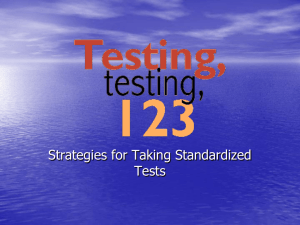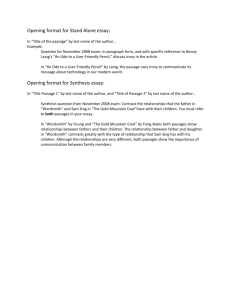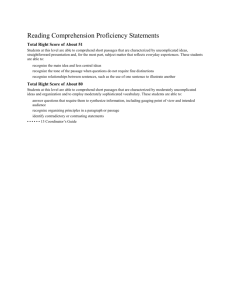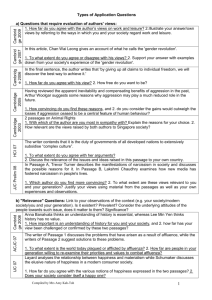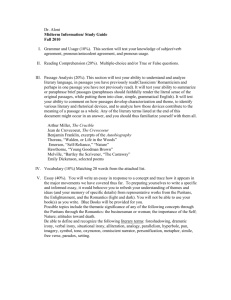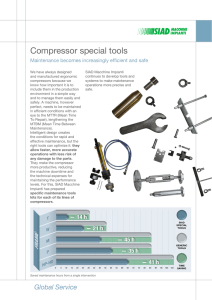The Short Interval Additional Dose (SIAD)
advertisement
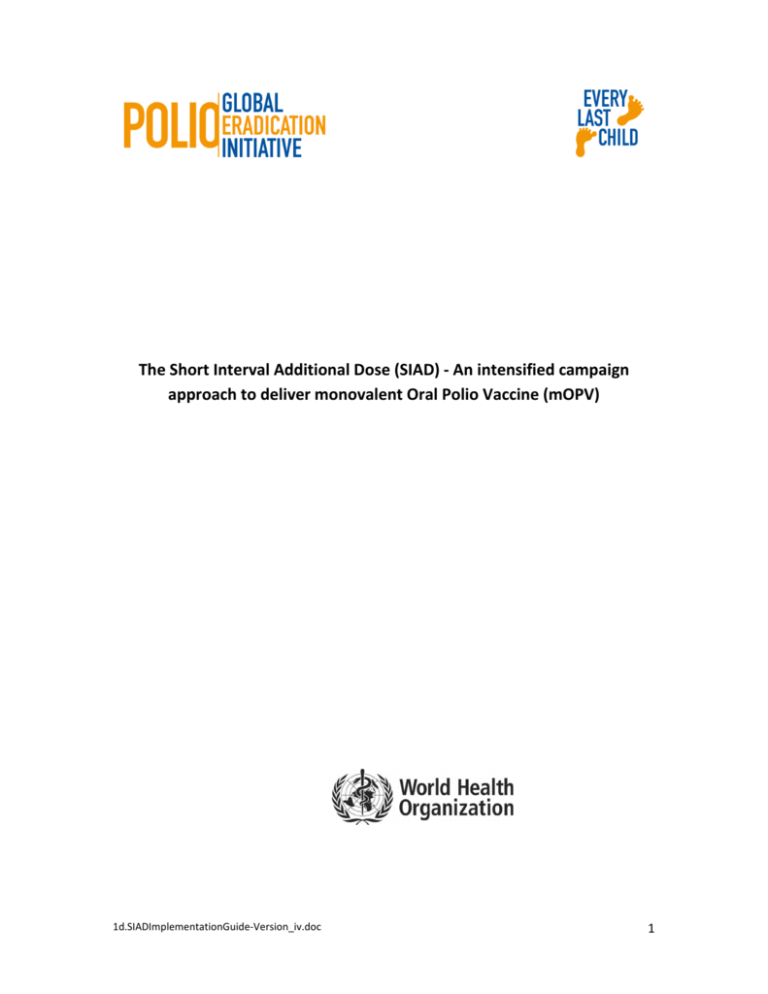
The Short Interval Additional Dose (SIAD) - An intensified campaign approach to deliver monovalent Oral Polio Vaccine (mOPV) 1d.SIADImplementationGuide-Version_iv.doc 1 Introduction What is SIAD? The Short Interval Additional Dose (SIAD) is an intensified approach to deliver two successive doses (passages) of monovalent Oral Polio Vaccine (mOPV) within a period of a few days (usually less than 2 weeks). The objective is to build up population immunity rapidly by taking advantage of the better sero-conversion with mOPV, together with intensive supervision and monitoring to ensure a campaign of the highest possible quality. Why use the SIAD approach? There are situations such as new outbreaks and importations of wild poliovirus when it is necessary to achieve a high level of immunity in a short time to limit the outbreak quickly. Also even if there is no new outbreak, security issues may only permit occasional rapid and intensive supplementary immunization contacts when the situation permits. Background Before monovalent OPV (mOPV) became available, the Global Polio Eradication Initiative (PEI) had used trivalent tOPV in 2 rounds with an interval of 4-6 weeks. The interval was adopted , because vaccine virus persists in the gut of recipients for that period of time, risking interference between the three different virus types in the OPV, while generating an immune response in the vaccinated child. However, most of the interference between serotypes in tOPV is due to type 2. Since the licensing of mOPV, studies in Nigeria have shown that approximately 67% of children will develop immunity to poliovirus type 1 after the first dose of mOPV1 as compared with approximately 35% of children after the first dose of tOPV. Similarly better sero-conversion rates have been estimated for immunity to poliovirus type 3 using mOPV3 as compared with tOPV. • • • The SIAD approach is founded on the principle that when monovalent vaccines are used there will be no interference in the process of sero-conversion when successive doses are administered. The advantage is that successive doses of mOPV enhance sero-conversion, and the time interval between doses or rounds can be reduced. One SIAD round consists of two ‘passages’ providing two opportunities for the target population to be reached during a short period of time, typically two passages of 5 days each separated by a two day interval. SIAD has the added operational advantage of enabling the field concentration of supervisors from other areas to be brought in to support quality implementation over the whole 2 week period . 1d.SIADImplementationGuide-Version_iv.doc 2 The SIAD Concept Figure 1 provides an outline of the SIAD concept. • A. The objective is to convert the ‘naïve’ target population A to ‘immune’ population C. • B. After the 1st passage, approximately 67% of population A will move to B (reached and seroconverting). • NR. Despite the best effort in the 1st passage, some of the target remain not reached ‘NR’ and will need a second opportunity to be vaccinated. • NC. In addition, Some proportion of the target may be reached in the 1st passage but do not seroconvert. • During the interval between the two passages, SIAD managers critically analyse the feedback from supervision, independent monitoring and the community to organize a better quality 2nd passage. • C. The 2nd passage will ensure that the NR and NC populations have a second opportunity to seroconvert, while the population B will receive aboosting effect. There will be no interference in seroconvertion with any of the population so that population A will be converted to population C at the end of the two passages. Inevitably there may be a small population that is not protected after 2 passages, but this will be minimized by the SIAD strategy. 1d.SIADImplementationGuide-Version_iv.doc 3 Schematic outline of the SIAD principle: population immunity outcome after 1 and 2 passages st 1 Passage 2 nd Passage NR B A C NC Population groups: A = "Naïve“ Target population st B = Reached 1 passage and seroconverting st NR = Not reached 1 passage & at risk st NC = Reached 1 passage, but not seroconverting st C = Reached 1 &/or 2 nd passage and seroconverting Selecting areas for the SIAD approach The SIAD approach is applicable to: o Response to WPV in an area that has previously been Polio free. o Addressing an identified area with persistent circulation despite traditional approach. o Insecure areas where a negotiated window of opportunity allows teams to go in and out in a short time. Experience with SIAD to date (see Annex 1) • In areas of chronic insecurity: Somalia in 2006; • In areas of ongoing conflict taking advantage of days of tranquility: Afghanistan and Pakistan 2009 • In areas of highly mobile populations: Turkana - Kenya in 2009 1d.SIADImplementationGuide-Version_iv.doc 4 Magnitude of target population Given the intensity of the of the SIAD approach and the requirements for intensive supervision, the recommended magnitude of the popualtion should be up to a maximum of 500,000 target population (3-5 medium sized districts) Operational arrangements The basis of the SIAD approach is an intensification of the usual House-to-House polio campaign. For general aspects of ensuring quality supplementary immunization activities, the reader is referred to the existing guidelines. In implementing SIAD, specific attention be paid to the following Duration o Each child should receive two opportunities for mOPV vaccination separated by approximately an interval of a few days. Campaign managers, vaccinators and the community must consider this two opportunity schedule as one whole package. o The duration of the campaign is determined by local circumstances. A 12 day approach can be conducted as 5(2)5 - i.e. 5 days campaign, followed by a 2 days break and again 5 days campaign. The 2 day break allows rest, evaluation of any gaps, re-orientation of activities and replenishment of supplies. Planning and Coordination o An effective overall coordination mechanism: the management unit is the district while the planning unit is the sub-district (next lower administrative level). o Micro-planning and mapping with great attention to detail to identify population settlements, boundaries and to assign daily team itineraries (movement plans). o Identification of teams based on the work load (urban about 150 children per day and per team, rural about 60-80) Supervision o intensive supervision: one international and 2-3 national supervisors for each 100 000 target population plus district and Team supervisors all of whom should remain in the field for 12-14 days continuously to ensure quality. Supply, Cold Chain and Logistics 1d.SIADImplementationGuide-Version_iv.doc 5 Since the SIAD consists of two passages, managers must order vaccines and materials for double the target population and plan for timely replenishment of the teams between the passages. o Managers should apply the flexible cold chain strategy - using the VVM as guide of o vaccine viability. Monitoring o A system of effective independent monitoring must be put in place as part of the plan Tally sheets should be modified to allow for identification and desegregation of data to identify children reached between the 2 different passages. o Agree on specific finger marking: first passage left little finger and second passage right little finger o Agree on specific house-marking allowing to distinguish between the two passages o Communication and Social Mobilization o The community must anticipate two opportunities. For some children this will mean two doses, for others a second opportunity to get one dose. This will require intensified advocacy, social mobilization and working with the community leaders. It is important for the community to know when the team will be where and to keep this "social contract" Detailed Logistical Requirements Sparse population areas Sparce populations mean significantly longer distances between clustered households (settlements). The number of teams is reduced with only the better vaccinators with knowledge of the area retained. Each team is composed of 2 vaccinators, a driver and a local guide. Each team is assigned o 1 car, o 1 cold box, 2 vaccine carriers and enough frozen ice-packs for the duration of the round o Up to 50 vials (1,000 doses) of monovalent OPV. o Markers and tally sheets The teams follow a pre-arranged circuit as defined in the micro-plan, and uses the ice packs from the cold box to replenish the operating Vaccine Carrier. The movement plan allows them to cover all settlements and return close to their original starting point at 1d.SIADImplementationGuide-Version_iv.doc 6 Day 5 of the campaign. After a 2 day break, campaign managers re-supply the vaccination teams with a new sets of ice-packs, vaccines etc to enable them to make a 2nd passage re-tracing the same circuit with improvements based on the 1st round experience and the feedback from the campaign supervisors, the community and the independent monitors deployed. Dense population areas In this scenario, transport is assigned not to teams, but to sub-district coordinators and supervisors who assemble and deploy several teams to their assigned areas according to the micro-plans. Similar to the option above, teams follow a pre-defined circuit/movement plan with clearly designated daily target areas. Team's catchment areas should cover adjacent areas for successive days. Teams are supplied with: o o o o 1 vaccine carrier 2-4 well frozen ice-packs and enough Adequate mOPV for the daily target for the team Fingers markers, chalk for house marking and tally sheets 1d.SIADImplementationGuide-Version_iv.doc 7 Detailed Implementation Requirements • Teams must try to reach every child with two doses of mOPV. Key message: The second passage may be a second dose for some, but a first dose for others. • Dynamic, mobile supervisors should follow plans and schedules that will include supervision of every team • Independent monitoring is required for both passages • Mark different fingers for each passage. For example left little finger first pasage, right little finger second passage. • A missed house or vacant house should not be re-visited during the 1st passage, a note should be taken to re-visit during the 2nd passage. An example of SIAD of 12 days total duration 1 2 3 4 First passage days 1 to 5 6 5 7 8 9 10 11 12 Interval days 6 and 7 Second passage days 8 to 12 1d.SIADImplementationGuide-Version_iv.doc 8 Annex 1 Summary of the experiences with implementing the SIAD to date Area Somalia: Timing Circumstances & Rationale Outcome Sept 2006 Insecurity with limited access in several areas of Somalia. A Polio outbreak. 216,032 children targeted 194,387 reached with 2 doses OPV, including Hobyo - where 90% of the children were zero dose. The areas targeted with SIAD stopped transmission earlier Oct 2009 following military operations, Swat remained totally inaccessible between November 2008 and August 2009. 19 WPV cases had been reported in 2009 after being polio free for over 4 years. SIAD round targeted 377,075 children 351,077 children (93% - Admin coverage) were reached. Of the 1399 children surveyed, 1205 (86%) had been vaccinated as verified by finger mark. Transmission was interrupted Aug and Oct 2009 Persistent WPV circulation despite 4 traditional rounds; insecurity and difficult terrain. 347,877 target population 368,173 children reached. Independent monitoring showed 75% of the children in the house-holds vaccinated with in both passages. 85% outside the household reached with both fingers marked. No break through transmission since SIAD Bay, Banadir, Middle & Lower Shebele, Hiran, Galgadud Pakistan Swat valley Kenya Turkana and 12 neighbouring districts in Pokot and Samburu areas 1d.SIADImplementationGuide-Version_iv.doc 9 Annex 2 SIAD CHECKLIST 1. Consider why SIAD is required approach: e.g. new outbreak that requires rapid and effective action; taking advantage of secure period; difficult terrain with limited period for access. Define area for SIAD. Recommended maximum population 500,000 (3 to 5 medium-sized districts) Decide on operational duration: 5-2-5 days or 3-2-3 days etc. 2. Make house-to-house SIA plans covering the defined area. Plans will have to be adapted to SIAD use to include 2 passages each of 5 or 3 days according to decision. Include detailed daily team movement plans for every team and separate supervisory plans Make a detailed plan for the interval days to include re-stocking of supplies, data analysis, corrective action, meeting with communities and teams etc. 3. Recruit competent international and national supervisors who can dedicate 2 weeks for the duration of the SIAD. Obtain transport for supervisors to ensure mobility for duration of SIAD 3. Provide detailed training to all teams and supervisors Explain the concepts of two opportunities, two doses, two passages and the safety of mOPV in multiple doses. 4. Standardize finger marking procedures and how to interpret them Obtain sufficient finger markers for two passages of whole population 5. Monitoring during each passage and making adjustments between 1st and 2nd passages During the break between 1st and 2nd passages supervisors should collect and analyze data, and meet with teams and communities to make corrective action for the 2nd passage. 6. Supplies sufficient for two passages Many supplies will need to be doubled to allow 2 passages: mOPV, ice packs, marker pens, monitoring forms Cold Chain: Refrigeration space needed for two passages: may need to split shipments to refrigerators. Ice pack freezers – calculate ice pack numbers and how many freezers needed to provide icepacks for two passages. 1d.SIADImplementationGuide-Version_iv.doc 10 7. Provide precise communication with the community served and local authorities Arrange for orientation meetings that will explain the need for two passages and the safety of two consecutive doses Between the 2 passages collect feedback information from communities on 1st passage to make improvements for 2nd. 7. Budgetary preparation for two passages Be prepared for costs to be almost doubled to pay for the increased supplies, logistics and personnel costs. 1d.SIADImplementationGuide-Version_iv.doc 11



